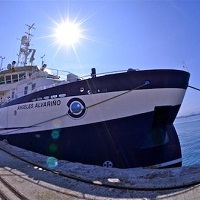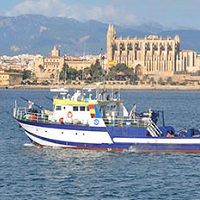Keyword
Chirp
55 record(s)
Type of resources
Categories
Topics
INSPIRE themes
Keywords
Contact for the resource
Provided by
Years
Formats
Status
-
Salt deformation and sub-salt fluid circulation in the Algero-Balearic abyssal plain(SALTFLU): 1) To identify the three dimensional structure of the salt deformation structures of the Algero-Balearic abyssal plain;2) to collect evidence of fluid migration, accumulation and extrusion at the seafloor; 3) to constrain the link between the observed overburden fluid circulation and deep (sub-salt) origins; 4) to link the fluid circulation pattern to the recent basin evolution with special regard to the tectonic stress propagation derived from convergence between the Africa and European plates.
-

Swath bathymetry and seismic studies using the following echosounders: EM710, TOPAS, EK60, EA600 and seismic Sparker. Also gravity cores and box core were used.
-

This survey has been projected in the frame of La Restinga Volcano monitoring. After a wide number of surveys conducted by R/V Ramon Margalef during the volcano crissis (from october 2011 to february 2012) the aim this time is to compleate a bathymetric surver again in order to find out possible changes in geomorphology, Sound velocity profiles will be carried out in order to obtain the best accuracy on the data adquired.
-

1. To obtain estimates of Nephrops burrows densities in the Gulf of Cádiz from a randomized isometric grid of UWTV stations spacing 4 nautical miles using the underwater images. 2. To define the Nephrops distribution in the Gulf of Cádiz 3. To obtain density estimates of bentho-demersal macrofauna species 4. To calibrate bentho-demersal macrofauna observed in the underwater videos and those obtained in the beam trawl. 5. To obtain and the occurrence of trawl marks on the sea bed 6. To measure oceanographic variables using a sledge mounted CTD 7. To collect sediment samples 8. To prospect circalittoral and bathyal areas without trawling activity 9. Sea bed morphological and backscatter analyses
-

MAO1407 Second survey of Mahón continental shelf. Before the dradge action of Mahón harbour a first survey using multibeam echosounder was conducted in january 2014 in order to the map the benthic habitats that could be affected. In this new survey the aim is to determinate the extension and impact that dradge debries has caused in the seabed using geophisical techniques. Multibeam echosounder and parametric subottom profailer had been used in the area. Data gatered will show the extend and thickness of dradge debries.
-

During the ABRIC-3 cruise, the acquisition of high resolution bathymetries of the fishing grounds in Blanes and Palamós submarine canyons have been carried out using the ship hull multibeamm echosounder. Sediment cores have been obtained to determine the rates of sedimentation in the axes of the canyons. TOPAS seismic profiles were also collected crossing the canyon rims and flanks..
-

- To obtain estimates of Nephrops densities through underwater videos with photogrammetric sled. - To obtain estimates of Nephrops burrows dendity. - To delimit the distribution of Nephrops in the Gulf of Cádiz. - To obtain estimates of bento-demersal macrofauna density present in the Nephrops fishing ground. - To calibrate bentho-demersal macrofauna observed in the underwater videos and those obtained in the beam trawl. - To prospect non-draggable areas of the circalitoral and batial to know the state of the bottom and the presence of commercial resources. - To gather complementary information on the action of the trawl gear in the seabed. - Oceanographic data collection. - Morphological analysis and acoustic response of the substrate through data acquisition bathymetry and reflectivity, as well as very high resolution seismic profiles of areas already prospected or pending to prospect. - To collect of sediment samples for sedimentological and community characterization of endofauna. - To explore the Portuguese continental margin of the Gulf of Cádiz near the Spanish border in relation to the continuity of the distribution of Nephrops and characterization seabed.
-

This survey main goal is to achieve the complete bathimetry of the designated area using multibeam echosounder EM710. After data procesing different DTM will be produced in order to characterize the area from a geomorphologic point of view. Sound velocity profiles will be carried out in order to obtain the best accuracy on the data adquired.
-

Bathymetry, Seismic work and Geophysical Survey of the submerged Paleolithic of the Cantabrica Sea continental platform
-

The aim of the cruise is to show students of the Master in Oceanography of the Vigo University, the various techniques performed on Oceanographic vessels used to study water colum, bottom sediments and zoobenthos.
 Catálogo de datos del IEO
Catálogo de datos del IEO